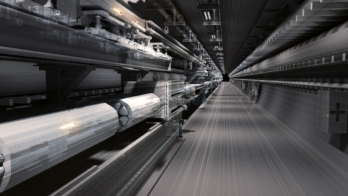Originally an accelerator laboratory, LBNL now covers a broad range of fields. Deputy director Pier Oddone outlines the vibrancy of the multidisciplinary approach.

Would E O Lawrence recognize his laboratory today? Founded in 1931 by the University of California as a venue for Lawrence’s successive generations of ever-larger cyclotrons, today’s Lawrence Berkeley National Laboratory (LBNL) is a thriving multidisciplinary institution pursuing basic and applied research across a broad front, with many of the most exciting discoveries occurring at the boundaries between disciplines. Strength in nuclear and particle physics, the foundational sciences of LBNL, is evident in key contributions to the Asymmetric B-factory at SLAC; the development of silicon vertex detectors for CDF, BaBar and ATLAS; major roles in building STAR for the Relativistic Heavy Ion Collider at Brookhaven and the detector for the Sudbury Neutrino Observatory; and the discovery of the accelerating expansion of our universe – to mention a few prominent examples. Yet the activities in these areas comprise only 10% of LBNL’s programme.
Growth and diversification notwithstanding, Lawrence would recognize at least three features that continue to define today’s laboratory. First, the campus connection. The Radiation Laboratory (Rad Lab) was first established as an entity within UC Berkeley’s Physics Department, and though most of its activities migrated in the 1940s to a hillside site adjacent to the campus – and though it is now an institution independent of the campus – the link remains firm. More than 200 faculty scientists and well over 300 graduate students pursue research at the laboratory, and it extends well beyond its physical boundaries to encompass a host of research labs and facilities on the Berkeley campus. Disciplinary strength from the campus faculty – joined with the orientation of the laboratory to solve problems of scale, and the enthusiasm of students and postdocs – create an effervescent mixture that drives the laboratory.
A second constant has been the central role of major facilities. Times have changed, of course, and so has the nature of the facilities appropriate to our urban site. The big, single-purpose machines of particle physics have been replaced with state-of-the-art facilities of a different scale, which cater to broader, multidisciplinary audiences. The 88 inch Cyclotron remains a productive tool dedicated to the national nuclear science community, but the newer National Center for Electron Microscopy, National Energy Research Scientific Computing Center (NERSC) and Advanced Light Source (ALS) are emblematic of today’s multidisciplinary reach. The ALS in particular ties the past to the future; it resides under the dome of the dismantled cyclotron whose size forced the Rad Lab off campus and onto its current hillside site. Its design in the late 1980s relied on the expertise of accelerator physicists who traced their intellectual lineage to Lawrence’s hand-picked colleagues. But there ends the resemblance to machines of the past; the ALS is an electron storage ring, a source of synchrotron radiation serving chemists, surface and materials scientists, atomic physicists and structural biologists from around the country. Also notable, but without even a distant parallel from Lawrence’s era, NERSC is one of the largest massively parallel computers in the civilian sector, serving more than 2000 users nationally.
Third, and most important, Lawrence would recognize the enduring spirit of team science that gave birth to the oldest of our national laboratories in the first place. Most surprising to him, perhaps, would be the extension of this spirit to encompass much of modern biology. Indeed, the Human Genome Project was the brainchild of the Department of Energy, overseer and principal funding source for the national laboratories, in recognition that old-fashioned bench biology would never get the job done. Three labs, including Berkeley, joined to form the Joint Genome Institute in 1997, a paradigm of team science and a key producer of human genome sequence data. Today, the era of modern biology is well launched – an era characterized by interdisciplinary teamwork. Engineers contribute instrumentation and robotic automation to ongoing genome-sequencing efforts. Computational scientists work to make sense of an exploding quantity of genomic and structural data. And even physicists have turned to such biological challenges as how proteins fold to assume their unique active configurations.
Teamwork and disciplinary fuzziness are also evident at the “nano” frontier. The next national user facility at Berkeley Lab is likely to be the Molecular Foundry, 7500 m2 of research laboratories and advanced instrumentation designed to bring together biologists, materials scientists, chemists and physicists working at the nanoscale. Cross-fertilization in this area is already evident in such concepts as protein nanowires, DNA scaffolds to array nanostructures, nanocomposites for bone replacement, quantum dots and magnetic nanoparticles as biological probes, and nanomaterials for efficient solar cells.
The constancy of teamwork is perhaps the key point. Computational power and instrumental probes capable of molecular or atomic-level resolution and manipulation are now exposing the physical roots even of fields recently dominated by individual investigators at their workbenches. Thus, a laboratory born of accelerator physics and nurtured by one man’s concept of team science has evolved into a multidisciplinary institution and now, logically, a truly interdisciplinary one – a laboratory still recognized for its contributions to particle physics and nuclear science, but increasingly committed to uniting the biological and physical sciences at the frontiers of knowledge.





